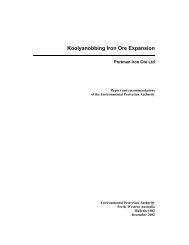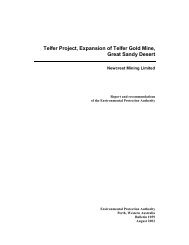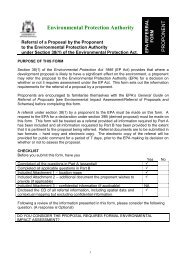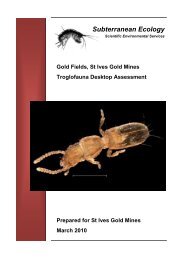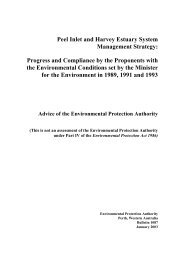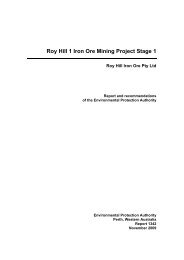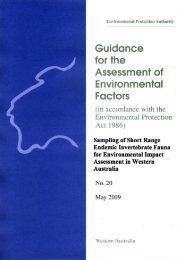Flora survey for Hamersley Drive recreation - Environmental ...
Flora survey for Hamersley Drive recreation - Environmental ...
Flora survey for Hamersley Drive recreation - Environmental ...
Create successful ePaper yourself
Turn your PDF publications into a flip-book with our unique Google optimized e-Paper software.
FRNP Improvement Project: Culham Inlet to <strong>Hamersley</strong> Inlet GF Craig– July 2010<br />
Previous biological <strong>survey</strong>s<br />
Vegetation and flora <strong>survey</strong>s have been carried out by:<br />
• Beard (1976, 1979) mapped the vegetation at 1:250 000 scale;<br />
• Aplin and Newbey (1990 a & b) described the vegetation and flora of the FRNP;<br />
• Chapman and Newbey (1995) established a series of monitoring quadrats <strong>for</strong> flora and trap<br />
lines <strong>for</strong> fauna across the FRNP (Appendix 6);<br />
• Chapman and Newbey (1987) documented plant species, land<strong>for</strong>m, geology and soil data<br />
<strong>for</strong> 309 vegetation sites in the FRNP;<br />
• Lamont and Witkowski (1995 and 1999) have measured the response to fire of Banksia<br />
species growing near Hopetoun;<br />
• in 2007, DEC Albany established monitoring plots north of <strong>Hamersley</strong> <strong>Drive</strong>, to determine<br />
vegetation response to the October 2006 fire. The fire followed from a prescribed burn<br />
between Eyre Range and East Mt Barren to achieve some ‘break up’ of the 1989 wildfire.<br />
Assessment of the state of biological knowledge and its relevance to the FRNP can be found in:<br />
• Hopper and Gioia (2004) discuss the evolution and conservation of the south-west’s flora in<br />
the context of the area being an International biodiversity hotspot. The FRNP is recognized<br />
as an area of particularly high diversity within the south-west;<br />
• Deegan (2005 and 2006) prepared a bibliography and review of the state of knowledge of<br />
the Fitzgerald Biosphere;<br />
• a list of the 1,665 plant taxa known from the Park is given in Newbey and Hickman (2008);<br />
• Barrett et al (2009) identified fire sensitive ecosystems in the South Coast region;<br />
• a Regional Strategic Management Plan <strong>for</strong> threatened species and ecological communities<br />
(Gilfillan et al. 2009) and Recovery Plan <strong>for</strong> those in the Fitzgerald Biosphere (Newell et al.<br />
2010).<br />
Fitzgerald Biosphere Reserve<br />
The national park is the core area of the Fitzgerald Biosphere which is a part-tenured management<br />
concept recognised by UNESCO’s Man and the Biosphere program. The Fitzgerald Biosphere Reserve<br />
is recognised as being a ‘hotspot’ within one of Earth’s 34 global biodiversity ‘hotspots’. The FRNP has<br />
approximately 1,660 plant taxa, containing over one-quarter (29%) of the south-west’s flora.<br />
The protection of biodiversity is increasingly seen as a global concern. This change in perspective has<br />
been associated with an increasing number of international instruments addressing biodiversity<br />
conservation issues. Some of these instruments, such as those relating to Biosphere Reserves, have<br />
been given some recognition in the Commonwealth’s Environment Protection and Biodiversity<br />
Conservation Act 1999. Moreover, the <strong>Environmental</strong> Protection Authority has recognised the<br />
importance of maintaining ecosystem/ecological processes <strong>for</strong> ecologically sustainable management<br />
(EPA 1999).<br />
The government of Western Australia occasionally discusses the Biodiversity Conservation Act in<br />
Parliament. This Act proposes to enhance legislation <strong>for</strong> the protection, restoration and sustainable use<br />
of our native plants, animals and other native organisms. The government recognises that “all of our<br />
natural biodiversity is important and it is our responsibility to ensure that our biodiversity is conserved”<br />
(Government of WA 2002).<br />
Vegetation Classification<br />
The <strong>survey</strong> area lies in the South West Botanical Province and the Esperance Biogeographic Region<br />
(after Cresswell and Thackway 1995) and is in the Barren Ranges System described by Beard (1973,<br />
1976), although the coastal dunes have affinity with the Fanny’s Cove System. These systems include<br />
four types of pediments:<br />
7



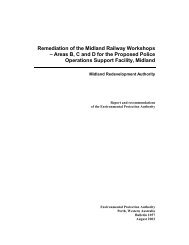
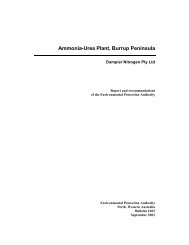
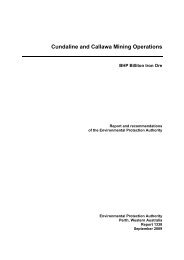
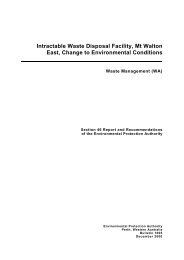
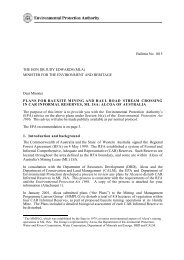
![[Project Title] - Environmental Protection Authority - The Western ...](https://img.yumpu.com/29001740/1/184x260/project-title-environmental-protection-authority-the-western-.jpg?quality=85)
